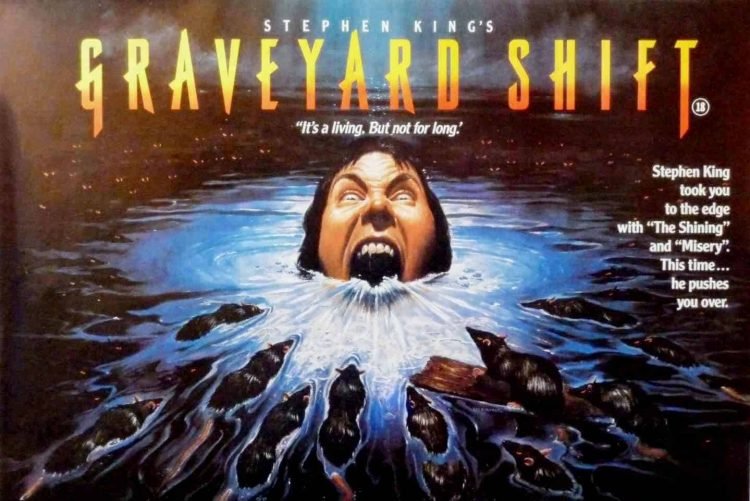Brad Dourif Steals the 1990 Stephen King Adaptation with a Loopy Cameo as a Crazed Exterminator
The Wikipedia page for 1990’s Graveyard Shift’ goes out of its way to discourage you from watching the film. For example, they note that while it scored the top spot at the box office in its first week of release due to King’s magical name, attendance nose-dived the following week due to negative word of mouth.
It also points out that the movie scored a dismal C- on CinemaScore and that Stephen King, who sold the rights for a mere 2,500 dollars to a collaborator who had worked as a location scout on Pet Semetary, thought it was one of the worst adaptations of his work, dismissing it as an “a quick exploitation picture.”
Of COURSE, it’s a quick exploitation picture. It’s about hideous mutated rats killing working-class drones underground. It’s not Amadeus. It did not have the production time and resources of Stanley Kubrick’s The Shining, to cite another adaptation King thought was a flaming pile of horseshit from a talentless jackass he’d like to punch right in his smug face.
Graveyard Shift’s dismal reputation dramatically lowered my expectations to non-existent.
I wasn’t expecting much but was eminently satisfied with a brown paper sack lunch of a movie.
Graveyard Shift suggests a gruesome hillbilly horror variation on Wages of Fear and Sorceror. As with those movies, the true villain is a capitalist free market system that reduces human life to a staggeringly small amount of money.
Life is cheap in Graveyard Shift. Rundown textile mill boss Warwick (Stephen Macht, with a mean Maine accent) is a hardass who thinks nothing of sending desperate people without better options into harm’s way for the sake of a paycheck. He's murderously cruel, management at its most malevolent and malignant.
Graveyard Shift smartly typecasts Brad Dourif as Tucker Cleveland, a hillbilly Vietnam veteran with a Southern drawl, earring, beloved rat-catching dog, and a horrifying monologue about ravenous rodents devouring the body of an unfortunate G.I during a traumatic stint in Nam.
Dourif doesn’t have much screen time, but he doesn’t need much to make an indelible impression as a charismatic lunatic who is way too into his job and too excited about the “killing” aspect.
The horror icon’s scenery-chewing supporting turn as a cracked veteran excited about killing all God’s creatures, human, rodent, and otherwise, represents the flashiest aspect of a tough, minimalist B movie.
David Andrews stars as John Hall, a widower who was once a college boy but now drifts from town to town and takes whatever work he can get.
The desperate blue-collar worker accepts a particularly soul-crushing job at Bachman Mills, a textile mill next to an abandoned graveyard overloaded with rats and much worse.
It’s a job that’s only slightly preferable to death, but it’s work, so he reluctantly accepts despite his asshole new boss’ clear-cut contempt for him.
John and his similarly luckless colleagues Brogan (Vic Polizos), Danson (Andrew Divoff), and Jane Wisconsky (Kelly Wolf) are hired to clean the mill’s rundown basement.
It’s a grueling, thankless task made even worse by the army of rats lurking underground.
These cursed souls know that they shouldn’t journey down into a rat-infested circle of hell, but they don’t have more appealing options. It's cleaning out the rat-infested basement of a mill or starving, not cleaning out the rat-infested basement of a mill or attending an Ivy League graduate school.
Warwick exploits his employees' poverty, desperation, and poor life choices to force them to do his bidding. He sexually harasses his female employees and forces the men who work under him to do things that he knows will likely result in a horrific death.
Graveyard Shift lives up and down to its title. Like the skin magazine where the short story first appeared, it’s a sleazy, lurid, nasty piece of work. It takes place largely underground and in the dark.
Its characters are hard cases with difficult lives and jobs that don’t just favor toughness; they require it.
This grimy adaptation is dark in myriad ways. The subject matter would be grim even without literal monsters in the mix, but its visual palette is dark as well, which serves multiple purposes.
The filmmakers made the most of a low budget by employing the Jaws strategy. Rather than showing the giant killer rat mutant monsters in their entirety, we only see horrifying glimpses of skinless faces and limbless bodies oozing with evil and pink, squiggly tales.
The real-life rat actors are cute. At their most aesthetically pleasing, rats just look like big mice. The same cannot be said of the mutated rat monsters, who possess bat wings and other stomach-churning accouterments.
Tom Savini was slated to direct Graveyard Shift in the late 1980s. Graveyard Shift could use an artisan like him in the director’s chair. The massive rodents run amok won’t make anyone forget Stuart Gordon or David Cronenberg, but they are appropriately stomach-churning and grotesque.
Like all sane people, I have a deep fear and loathing of rats that Graveyard Shift exploits. Rats are repellent creatures, gross little monsters under the best of circumstances.
When it was released, Graveyard Shift did not attract a single positive review, but it gave me exactly what I was looking for: a nasty, no-frills B movie with an unrelentingly bleak worldview.
For fellow Brad Dourif super-fans, it’s worth seeing his performance alone. He truly brings it.
Graveyard Shift is no masterpiece, just an effective horror movie.
Nathan needed expensive, life-saving dental implants, and his dental plan doesn’t cover them, so he started a GoFundMe at https://www.gofundme.com/f/support-nathans-journey-to-dental-implants. Give if you can! I




